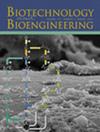Engineering an Overflow-Responsive Regulation System for Balancing Cellular Redox and Optimizing Microbial Production
IF 3.5
2区 生物学
Q2 BIOTECHNOLOGY & APPLIED MICROBIOLOGY
引用次数: 0
Abstract
Escherichia coli accumulates acetate as a byproduct in fast growth aerobic conditions when using glucose as carbon source. This phenomenon, known as overflow metabolism, has negative impacts on cell growth and protein expression, also causes carbon loss during biosynthesis in most microbial production scenarios. In this study, we regarded the “waste” metabolite as a useful metabolism indicator, constructed an overflow biosensor to monitor the change of acetate concentration and converted the signal into various regulation outputs. Phloroglucinol is a phenolic compound with several derivatives that exhibit various pharmacological activities. By applying the bifunctional dynamic regulation system on the phloroglucinol production, we released the cellular redox pressure in real-time and reduced the waste of carbon flux on overflow metabolism. Finally, carbon flux was redirected more favorably towards the desired product, resulting in a boosted phloroglucinol titer of 1.30 g/L, increased by 2.04-fold. Overall, this study explored the use of a central byproduct-responsive biosensor system on improving cellular metabolic status, providing a general approach for enhancing bioproduction.设计一种溢出反应调节系统,以平衡细胞氧化还原作用并优化微生物生产
本文章由计算机程序翻译,如有差异,请以英文原文为准。
求助全文
约1分钟内获得全文
求助全文
来源期刊

Biotechnology and Bioengineering
工程技术-生物工程与应用微生物
CiteScore
7.90
自引率
5.30%
发文量
280
审稿时长
2.1 months
期刊介绍:
Biotechnology & Bioengineering publishes Perspectives, Articles, Reviews, Mini-Reviews, and Communications to the Editor that embrace all aspects of biotechnology. These include:
-Enzyme systems and their applications, including enzyme reactors, purification, and applied aspects of protein engineering
-Animal-cell biotechnology, including media development
-Applied aspects of cellular physiology, metabolism, and energetics
-Biocatalysis and applied enzymology, including enzyme reactors, protein engineering, and nanobiotechnology
-Biothermodynamics
-Biofuels, including biomass and renewable resource engineering
-Biomaterials, including delivery systems and materials for tissue engineering
-Bioprocess engineering, including kinetics and modeling of biological systems, transport phenomena in bioreactors, bioreactor design, monitoring, and control
-Biosensors and instrumentation
-Computational and systems biology, including bioinformatics and genomic/proteomic studies
-Environmental biotechnology, including biofilms, algal systems, and bioremediation
-Metabolic and cellular engineering
-Plant-cell biotechnology
-Spectroscopic and other analytical techniques for biotechnological applications
-Synthetic biology
-Tissue engineering, stem-cell bioengineering, regenerative medicine, gene therapy and delivery systems
The editors will consider papers for publication based on novelty, their immediate or future impact on biotechnological processes, and their contribution to the advancement of biochemical engineering science. Submission of papers dealing with routine aspects of bioprocessing, description of established equipment, and routine applications of established methodologies (e.g., control strategies, modeling, experimental methods) is discouraged. Theoretical papers will be judged based on the novelty of the approach and their potential impact, or on their novel capability to predict and elucidate experimental observations.
 求助内容:
求助内容: 应助结果提醒方式:
应助结果提醒方式:


